STAMPS - SECOND ANGLO BOER WAR
On the outbreak of war on the 11th of October 1899, the Transvaal and O.F.S. commandos invaded Cape Colony and Natal. On the Cape front they occupied a territory about 25 miles parallel with the border, in which republican issues were valid for postage. After early setbacks, the British under Lord Roberts advanced to the relief of Kimberley and Mafeking and, following the surrender of General Cronje at Paardeburg, Roberts entered Bloemfontein on the 13th March 1900 unopposed.
Following the occupation, the stamps and stationery of the O.F.S. were immediately declared invalid. Within a few days, British Occupation issues were produced by the printers, Curling & Co., locally, in Bloemfontein, by overprinting the republican issues "V.R.I." (Victoria Regina Imperatrix).
"V.R.I." overprints had to be applied to postage, revenue and telegraph stamps, leading to a complex series of settings and numerous varieties.
Altogether 17 separate printing operations have been so far ascertained and the following is the sequence in which it is believed they were carried out:
1. The First Postage issue. Feature: all V's are thin and the stops after the letters are level with the base of the letters; all current values printed including both the 6d blue and the 6d carmine.
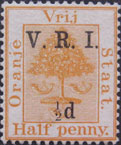
2. The First Revenue issue. Feature: all V's thin and all stops level; £1 and £5 values only. Examples are rare and consequently very little is known about this setting, but it is believed to have been of either 40 or 60.

3. First 6d revenue. Feature: thin V's and level stops; value in light-face type.

4. Second revenue. 1/-, 5/- and 10/- values. Features: thin V's and stops mostly raised, but there are 18 level stops spread over 11 stamps in the setting.

5. Telegraph. Values: 1d, 3d, 6d blue, 1/- telegraph. Features: thin V throughout, and most of the stops raised, but there are 13 level stops distributed over 10 stamps; no overprinted value.

6. Second Postage. Values: ½d, 1d, 2d, 3d, 4d, 6d carmine, 6d blue, 1/-, 5/- postage.
Features: thin V throughout and most of the stops raised, but there are 8 level stops distributed over 4 stamps; value in bold face type.
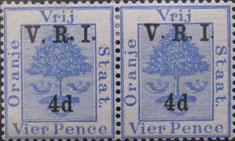
7. Third Postage. Values: ½d, 1d, 2d, 2½d, 3d, 6d blue, 1/- 5/- postage. Features: thin V on most stamps and all stops raised, but in early states there are 7 thick V's on Nos. 5, 17, 23, 39, 45, 47 and 48. The thick V on No. 47 soon became damaged and was replaced by a normal thin V. Value in bold face type.
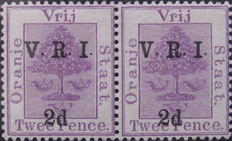
8. First Army Telegraph. Values: 1d, 3d, 6d blue and 1/- postage. Feature: identical with the Third Postage setting but with "AT" instead of value.
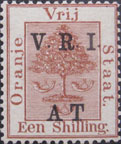
9. Third Revenue. Values: 1/-, 1/6, 2/-, 3/-, 6/-, 7/-, £2, £4 and £5 revenue. Features: thick V's on Nos. 5, 17, 23, 39, 45 and 48. Stops raised, but level stop after "s" on the shilling values. Value in bold face type on shilling values and light face type on pound values.

10. Fourth Postage (first part). Values: ½d, 1d, 2½d and 6d carmine. Feature: thick V's on Nos. 2, 14, 20, 40, 43 and 46 and it is a mirror image of the later state of the third setting. Value in bold face type. The printing was interrupted in order to print more telegraph stamps.

11. Second Army Telegraph. Values: 5/- postage, 10/-, £1 and £4 revenue. Feature: identical with the fourth postage setting but with "AT" instead of the value.
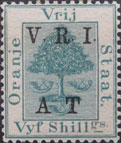
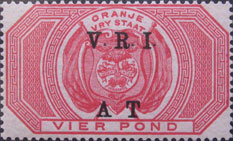
12. Fourth Postage (second half). Values: ½d and 1d. Feature: similar to the first half, i.e. prior to the Second Army Telegraph, but can be identified by small type variations.
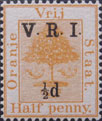
13. Fourth Revenue. Values: 4/-, 5/-, 9/-, £1, £3 and £5. Features: thick V's on Nos. 2, 8, 11 and 22. Stops raised, no stop after value, and value in bold face type.
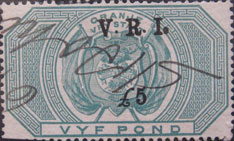
14. Second 6d Revenue. Features: Thick V's on Nos. 10, 19, 22 and 25; raised stops and value in bold face type.
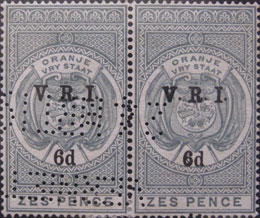
15a. Third Army Telegraph. Value: 1/- postage. Setting probably identical with the fifth postage setting. No panes known to exist and examples which can be identified with a fifth postage setting variety are rare.
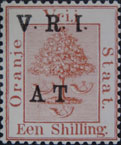
16. Sixth Postage. Values: 2½d and 6d carmine. Features: part of the setting of the Fifth Postage, but with level stops, used to overprint small blocks. Printing is usually inky, perhaps from the use of uncleaned type face. Multiples are rare.
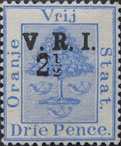
17. Third 6d Revenue. Feature: Light face type and level stops from a new format; no type varieties.
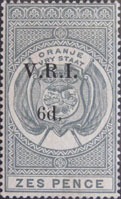
18. Fifth Revenue. Values: 1/-, 1/6, 2/-, 3/-, 6/-, 10/-, £2 and £3. Feature: Light face type from a new fount.
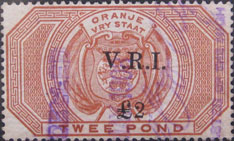
Some of the major varieties found in the V.R.I. Settings
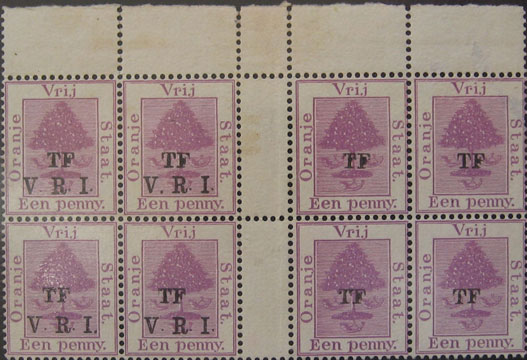
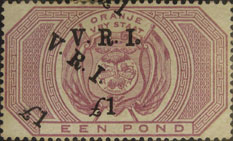
Home